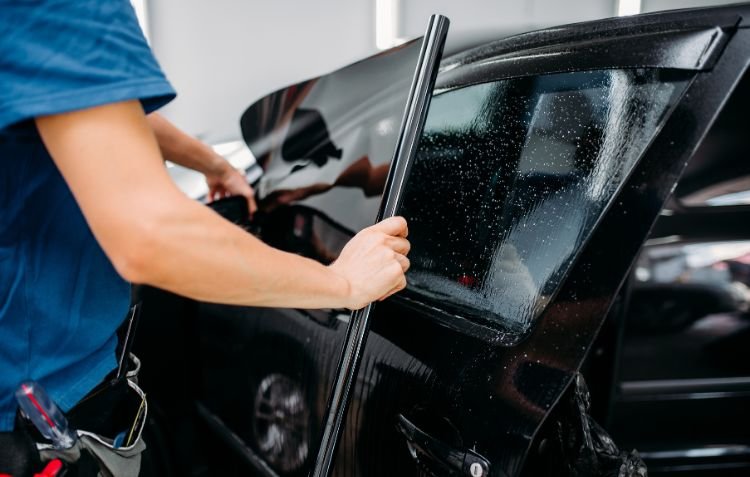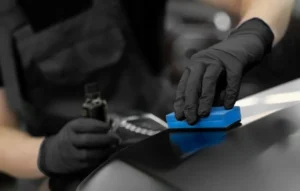Car window tinting has become increasingly popular in 2025, with more car owners recognizing its practical benefits beyond aesthetics. Whether you’re looking to reduce heat, block harmful UV rays, or enhance privacy, tinting your car windows can provide a range of advantages. Additionally, tinted windows help preserve your vehicle’s interior by preventing sun damage, reducing glare for safer driving, and even improving fuel efficiency by minimizing air conditioning use.
However, one of the most common questions among car owners is: How much to tint car windows? The cost can vary significantly depending on factors like the type of tint, vehicle size, and location. In this guide, we’ll break down the different pricing options, explore ways to get the best value deals, and help you make an informed decision. Keep reading to discover everything you need to know about car window tinting costs in 2025!
Table of Contents
ToggleUnderstanding Car Window Tinting
Car window tinting is a process where a thin, transparent or darkened film is applied to the interior of vehicle windows. This film serves multiple purposes, offering both aesthetic and functional benefits.
Definition and Purpose
Car window tinting involves adhering a specialized film to the glass surface to control the amount of sunlight entering the vehicle. The primary objectives of tinting include:
- UV Protection: Blocks harmful ultraviolet rays, reducing sun exposure risks.
- Heat Reduction: Helps keep the interior cooler, reducing the need for air conditioning.
- Glare Reduction: Enhances visibility by minimizing glare from sunlight and headlights.
- Privacy Enhancement: Darker tints provide increased privacy and security.
Benefits of Window Tinting
The advantages of tinted windows go beyond just aesthetics.
- Interior Preservation: Prevents fading, cracking, and deterioration of upholstery and dashboard materials.
- Skin Protection: Blocks up to 99% of UV rays, reducing the risk of skin cancer. The Skin Cancer Foundation states that prolonged UV exposure through car windows contributes to premature aging and skin damage.
- Enhanced Comfort: Reduces glare, making driving safer and more comfortable.
- Improved Fuel Efficiency: Helps maintain a cooler cabin, decreasing air conditioning use and improving fuel economy.
Factors Influencing Tinting Costs
Car window tinting costs vary based on several factors, including the type of film used, the size of the vehicle, and regional price differences.
Type of Tinting Film
Different tinting films come at various price points, each offering unique advantages:
- Dyed Film: The most affordable option, providing basic privacy and glare reduction. However, it has a shorter lifespan and may fade over time.
- Metalized Film: More durable than dyed film, offering better UV and heat reduction. However, it can interfere with electronic signals like GPS and radio reception.
- Ceramic Film: A premium choice that blocks heat and UV rays effectively without affecting electronics. It is the most expensive but offers the best performance and longevity.
Vehicle Type and Size
The cost of tinting varies depending on the type and size of the vehicle:
- Sedans: Typically the most affordable due to fewer and smaller windows.
- SUVs & Trucks: Higher costs due to larger windows and increased surface area.
- Luxury Vehicles: More expensive because of advanced window designs and specialized installation requirements.
Regional Variations
Tinting prices also fluctuate based on location:
- Urban Areas: Higher demand and stricter regulations often lead to higher costs.
- Rural Areas: Lower demand and fewer restrictions can result in more affordable pricing.
- State Laws & Regulations: Some states have strict window tinting laws, which can affect pricing and available options.
Average Costs of Window Tinting in 2025
The cost of car window tinting in 2025 varies depending on the type of tint film, vehicle size, and installation method. Below is a breakdown of pricing to help you estimate expenses.
Price Range Overview
Different tint films come at varying price points based on quality and performance:
- Dyed Film: $100 to $200 for a standard four-door sedan. It’s the most affordable but has a shorter lifespan.
- Metalized Film: $200 to $500, depending on vehicle size. Offers better durability and UV protection but may interfere with electronic signals.
- Ceramic Film: $400 to $800+ for premium installations. Known for superior heat rejection and longevity, it does not interfere with electronic devices.
Cost Breakdown by Vehicle Type
- Sedans: Usually range between $200 and $500, depending on the type of tint selected.
- SUVs & Minivans: Due to their larger window surface area, costs can range from $250 to $700.
- Trucks: Generally priced between $200 and $600, depending on the cab size and number of windows.
DIY vs. Professional Installation
If you’re considering a DIY tint kit, expect to pay as little as $40 to $100. While DIY installation can save money, it has drawbacks:
- Risk of improper application: Air bubbles, peeling, and uneven tinting can occur.
- No professional warranty: Many DIY kits don’t include warranties, meaning you may need to redo the tint at an additional cost.
- Legal compliance issues: Professional installers ensure that the tint meets local laws and regulations.
Professional installation, while more expensive, provides:
- Higher-quality results with expert application.
- Warranty coverage for both the film and installation.
- Legal compliance to prevent fines or tint removal.
How to Get the Best Value Deals

Finding the best deals on car window tinting requires research, timing, and selecting a provider that offers quality service at a fair price.
Research and Compare Providers
To secure the best deal, follow these steps:
- Check online reviews: Look for feedback on Google, Yelp, and other review platforms.
- Ask for recommendations: Friends, family, and auto forums can provide trusted suggestions.
- Obtain multiple quotes: Contact at least three different service providers to compare pricing, services, and warranties.
Seasonal Discounts and Promotions
Many tinting businesses offer promotions at specific times of the year:
- Off-Peak Seasons: Winter and early spring often see lower demand, leading to discounted rates.
- Holiday Sales: Many providers offer deals around Black Friday, New Year’s, and Memorial Day.
- Bundle Discounts: Some auto shops provide discounted packages when tinting multiple vehicles or combining services like paint protection film installation.
Warranty and Aftercare Services
When selecting a tinting provider, consider warranty coverage and aftercare services:
- Warranty on the Film: Ensure the service includes a lifetime or multi-year warranty against bubbling, peeling, and fading.
- Installation Warranty: Some companies offer free corrections if issues arise after installation.
- Aftercare Services: Look for providers that offer free inspections or maintenance tips to prolong tint durability.
By taking these factors into account, you can ensure high-quality tinting at the best price while avoiding costly mistakes.
Legal Considerations for Car Window Tinting
Car window tinting is subject to legal restrictions that vary by region. Understanding and adhering to these laws is essential to avoid penalties and ensure compliance.
Understanding Tinting Laws
- Tinting laws differ by state, province, or country and regulate factors like:
- Visible Light Transmission (VLT %) – The percentage of light allowed through the tint.
- Reflectivity Restrictions – Limits on how reflective the tint can be.
- Windshield and Front Window Rules – Many regions impose stricter limits on front windows than rear windows.
- Non-compliance can result in fines, mandatory tint removal, or vehicle inspections.
- To avoid violations, check with the Department of Motor Vehicles (DMV) or local transport authority for up-to-date regulations.
Ensuring Compliance
- Consult professional installers who are knowledgeable about regional tinting laws.
- Request a compliance certificate or legal documentation after installation, especially for ceramic or darker tints.
- Some states require stickers or manufacturer certifications to confirm that the tint meets legal standards.
- If traveling between states or countries, ensure your tint is legal in multiple jurisdictions to prevent unexpected fines.
By staying informed and working with reputable installers, you can legally enjoy the benefits of window tinting without complications.
Conclusion
Car window tinting offers numerous benefits, including UV protection, heat reduction, and enhanced privacy. However, the cost varies based on factors like film type, vehicle size, and location. In 2025, standard tinting prices range from $100 for basic dyed film to over $800 for premium ceramic tinting.
When considering DIY vs. professional installation, DIY kits can be cost-effective but may lead to installation errors and lack of warranty. Professional tinting ensures higher quality, legal compliance, and long-term durability.
To secure the best deal:
- Research reputable tinting providers and compare quotes.
- Look for seasonal discounts and warranty offers to maximize value.
- Verify legal compliance with local regulations before installation.
Ultimately, investing in a high-quality tinting service ensures comfort, protection, and legal peace of mind. By following these guidelines, you can make an informed, cost-effective decision for your vehicle.
If you enjoyed learning about How much to tint car windows, explore more insightful articles on lifestyle, business, and culture at The Fast Upload. Stay informed with engaging and well-researched content!
FAQs
How long does window tinting last?
High-quality automotive films typically last between 5 to 10 years, depending on the film type and exposure to sunlight.
Will window tinting affect my rear defroster?
Properly installed tint does not negatively impact the rear defroster; it can even help distribute heat more evenly.
How should I clean tinted windows?
Wait a week after installation before cleaning. Use a soft, clean microfiber cloth and an ammonia-free cleaner, such as vinegar-based solutions.
Can I replace existing window film?
Old tint must be professionally removed before applying new film to prevent damage to the rear-window defroster.
Is window tinting legal?
Tinting laws vary by region, specifying permissible tint levels for each window. Consult local regulations to ensure compliance.













